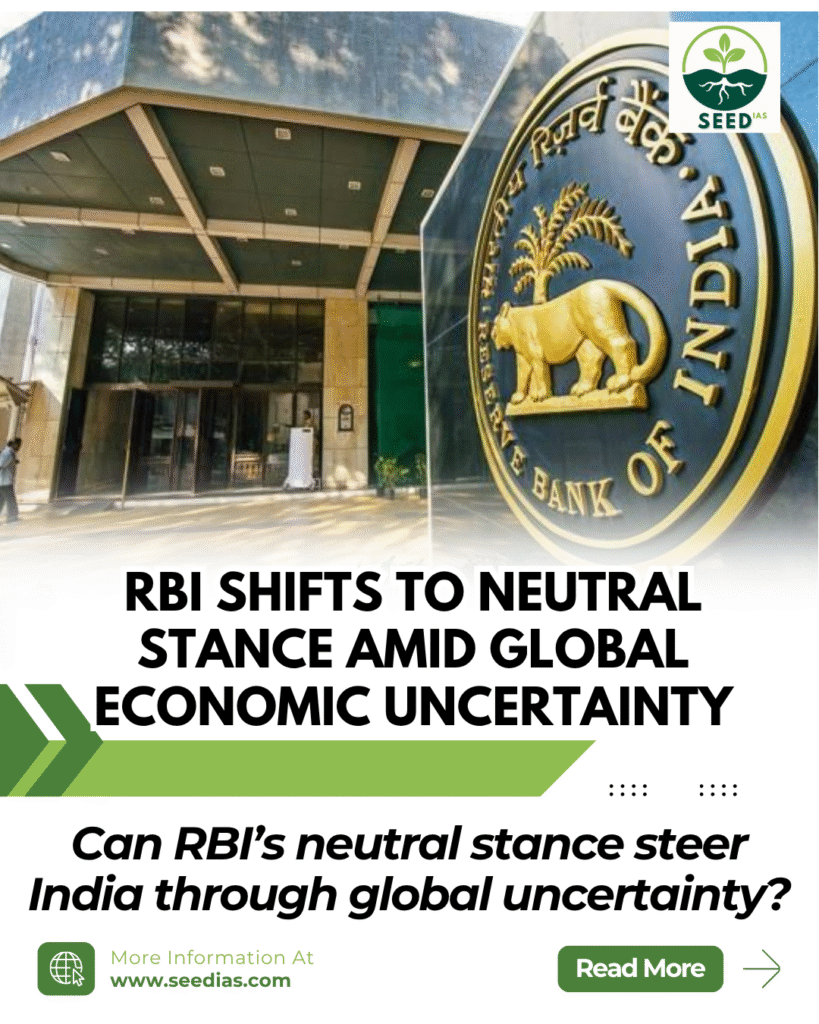Why in NEWS
In the June 2025 MPC meeting, the Reserve Bank of India (RBI) noted the fragile global economic outlook. Despite a 100 basis points (bps) rate cut since February 2025, inflation remains sticky. With limited room for monetary expansion and rising external risks, the RBI shifted from an accommodative to a neutral policy stance.
Key Terms / Concepts
| Term | Explanation |
|---|---|
| Accommodative Stance | RBI keeps interest rates low or reduces them to support economic growth and increase liquidity. |
| Neutral Stance | RBI retains flexibility to raise or cut interest rates based on inflation or growth indicators. |
| Basis Points (bps) | A unit of measure for interest rates, where 1 bps = 0.01%. |
What is the Monetary Policy Committee (MPC)?
- Constitution: Formed under Section 45ZB of the RBI Act, 1934.
- Members: 6 (3 from RBI including the Governor as Chairperson, and 3 nominated by the Government of India).
- Mandate: Set the policy repo rate to achieve inflation targeting and ensure price stability while considering growth.
- Decision-making: Each member has one vote; the Governor has a casting vote in case of a tie.
- Meetings: At least four times a year; decisions and minutes are published for transparency.
What is Monetary Policy?
| Aspect | Details |
|---|---|
| Definition | Regulation of the money supply and interest rates by the RBI to achieve macroeconomic goals. |
| Legal Basis | RBI Act, 1934 |
| Primary Objective | Price stability (Inflation targeting: 4% ± 2%) |
| Secondary Objectives | Promote growth, employment, and external stability. |
Tools of Monetary Policy
Quantitative Tools (General Control of Liquidity)
| Instrument | Function |
|---|---|
| Cash Reserve Ratio (CRR) | Portion of NDTL banks must hold with RBI in cash. |
| Statutory Liquidity Ratio (SLR) | Portion of NDTL held in liquid assets like cash, gold, securities. |
| Open Market Operations (OMO) | Buying/selling government securities to control liquidity. |
| Repo Rate | Rate at which RBI lends short-term funds to banks with collateral. |
| Reverse Repo Rate | Rate at which RBI borrows from banks. |
| Bank Rate | Long-term lending rate without collateral. |
| Marginal Standing Facility (MSF) | Banks borrow overnight from RBI using excess SLR holdings. |
| Liquidity Adjustment Facility (LAF) | Daily and term repo operations to manage liquidity. |
| Market Stabilisation Scheme (MSS) | Special bonds to mop up excess liquidity when usual OMOs are insufficient. |
Qualitative Tools (Selective Credit Control)
| Tool | Description |
|---|---|
| Margin Requirement | Controls speculative credit by setting limits on loan value relative to asset value. |
| Consumer Credit Control | Regulates installment credit terms for consumer goods. |
| Rationing of Credit | Limits credit to specific sectors (e.g., real estate) to curb inflationary trends. |
| Moral Suasion | RBI persuades banks to adopt desired practices. |
| Direct Action | RBI penalizes or restricts banks for policy violations. |
In a nutshell
Mnemonic: RPM-SMALL
Repo,
Policy Rate,
MSS,
SLR,
MSF,
Accommodative/Neutral,
LAF,
Liquidity Tools.
These instruments equip RBI to steer the economy through inflation and instability while fostering balanced growth.
Prelims Practice Questions
- Consider the following statements:
- The Monetary Policy Committee is chaired by the Finance Minister.
- The repo rate is the rate at which the RBI lends money to commercial banks.
- CRR is a tool used to manage foreign exchange reserves.
Which of the above are correct?
A. 1 and 2 only
B. 2 only
C. 2 and 3 only
D. 1 and 3 only
- Which of the following instruments is considered a qualitative tool of monetary policy?
A. Repo rate
B. SLR
C. Margin requirement
D. Bank rate - What does a neutral stance of monetary policy imply?
A. RBI will only cut interest rates.
B. RBI will only raise interest rates.
C. RBI retains flexibility to adjust rates based on economic trends.
D. RBI will maintain current interest rates for the long term.
Mains Practice Questions
- How does the Monetary Policy Committee contribute to ensuring economic stability in India? Discuss the tools at its disposal and recent policy trends. (GS 3 – Economy)
- In the light of the RBI’s shift from an accommodative to a neutral stance, examine the challenges of balancing growth and inflation in India’s monetary policy. (GS 3 – Economic Development)
Prelims Answers with Explanations
| Q.No | Answer | Explanation |
|---|---|---|
| 1 | B | MPC is chaired by RBI Governor. CRR manages liquidity, not forex. |
| 2 | C | Margin requirement is a qualitative tool; others are quantitative. |
| 3 | C | A neutral stance gives RBI flexibility to raise or cut rates as needed. |
















